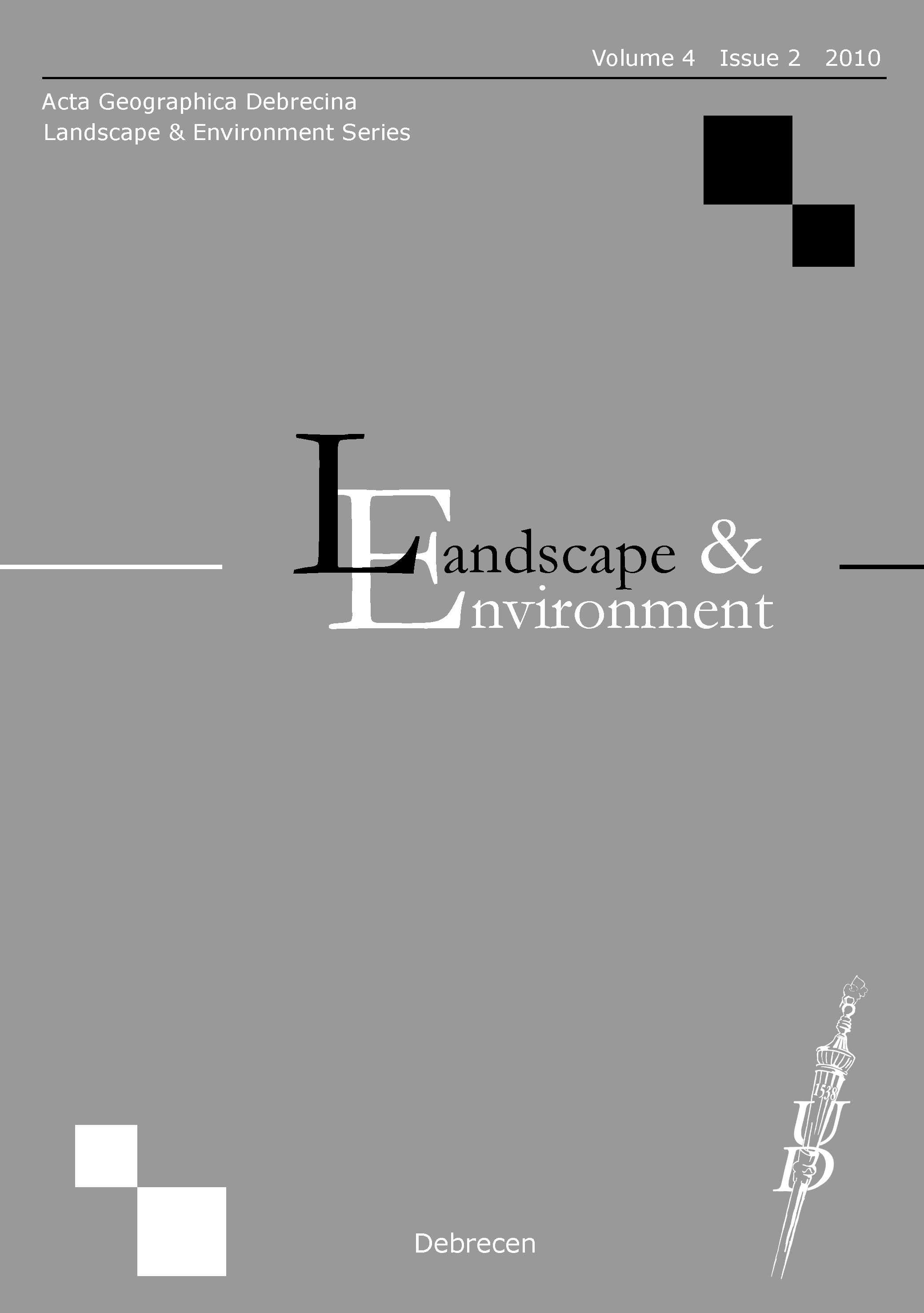Vol. 4 No. 2 (2010)
Myga-Piatek, U.: Directions and prospects of transformation in cultural landscapes of Poland - considerations and attempts of evaluation
Toker, E. - Yagmurlu, F.: Tectono-sedimentary evolution of the Eocene transgressive deposits in the Acigöl, Burdur and Isparta areas (SW Turkey)
Demer, S. - Memis, Ü. - Özgür, N.: Investigation of drinking water quality in Isparta, SW-Turkey
Megyeri-Runyó. A.: Environment protection and its reflection in the environmental consciousness of the inhabitants in a middle-sized town (Vác, Hungary)
##issue.tableOfContents##
Articles
-
Directions and prospects of transformation in cultural landscapes of Poland - considerations and attempts of evaluation
44-57Views:76The article points to several very up-to-date issues that occur in relation with the vanishing of traditional forms of land use and introduction of new, other than indigenous, management styles in Poland. Current processes of deterioration of the structure of the cultural landscapes have been discussed with regard to natural values and the historical process of land management by man. The article is a peculiar case study for quite common negative transformation of the polish countryside caused by relatively free use of the space, legal negligence, low awareness and poor identification of residents with the landscape – the countryside which loses its peculiar and typical features as the result of “mass consumption”. The text also presents positive examples of care taken for the regional landscape and lists initiatives aimed at improving the image of polish area.
pdf56 -
Tectono-sedimentary evolution of the Eocene transgressive deposits in the Acigöl, Burdur and Isparta areas (SW Turkey)
58-70Views:132The Eocene transgressive deposits of the Acıgöl, Burdur and Isparta basins are the best exposed of the SW Turkey and shed light on one of the outstanding problems of the tectono-sedimentary evolution during paleotectonic and neotectonic period. In the present paper we describe a tectonic model of the progressive foreland migration of the allochthonous units such as Lycian and Antalya nappes, initial emplacement onto stable carbonate platform in the Early Oligocene, carrying piggy-back basins and incorporating from alluvial fan to deep-marine deposits recognized in these terrigenous successions. In general, the facies and structural observations on the overall Mid-Late Eocene clastic sequences, outcropping in behind the Lycian nappes, indicate: i) the alluvial fan to shallow marine settings of the Başçeşme Fm in Acıgöl, ii) the Varsakyayla Fm in Burdur and iii) proximal to distal flysch facies trend of the Kayıköy Fm in Isparta. The collected data allow us to hypothesize that the Mid-Late Eocene tectono-sedimentary history was characterized by a terrigenous clastics, probably lying on the constructing tectonic edifice and then deformed and covered by a piggy-back like sequence. The tectono-sedimentary evolution of the Eocene transgressive in SW Turkey has been probably developed through a progressive migration towards the foreland basin.
pdf113 -
Investigation of drinking water quality in Isparta, SW-Turkey
71-82Views:92The study area located in the western part of the Tauride carbonate axis consist mainly of Mesozoic to Tertiary autochthonous and allochthonous rock assemblages, Plio-Quaternary volcanics and pyroclastic deposits. In this study, to determine of the hydrogeochemical features of drinking water system in Isparta and environs a great number of water samples was collected from total 46 locations. According to the hydrogeochemical analyses, the waters in the study area can be considered as CaMg-HCO3 and Ca-HCO3 exchange type waters. It is concluded that the results are comparable with national (Turkish Standards Institution – TS 266 2005) and international (World Health Organisation – WHO 2006, United States-Environmental Protection Agency – US EPA 2002 and European Union – EU 1998) drinking water standards. The results of hydrogechemical analyses show that the Eğirdir Lake waters are dominated in drinking water system of Isparta. Nowadays, the high fluorine contents in drinking waters from Isparta and environs are reduced by mixing process with the waters of Eğirdir Lake so that the drinking waters of Isparta have standard fluorine values in some cases and have fluorine contents below standard values (<0.5 mg/l) in most cases. F - contents in waters below the standard value (<0.5 mg/l) may give rise to dental and medicine problems. Therefore, mixing operations for the drinking waters used in Isparta must be carried out very carefully.
pdf85 -
Environment protection and its reflection in the environmental consciousness of the inhabitants in a middle-sized town (Vác, Hungary)
83-94Views:126Abstract The paper presents the role of urban environmental protection in sustainable development while analysing the factors influencing the environmental consciousness of the inhabitants of a middle-sized town based on a general model, together with the role of environmental consciousness in solving environmental protection problems at settlement level. My particular research focused on characterising the environmental state of Vác, with a population of 35000 people, and on the knowledge and environmental consciousness of the inhabitants. In the course of the representative questionnaire survey, 439 people gave assessable answers. Questions were related to the most significant environmental problems (air pollution, water contamination, sewage treatment, waste management). Answers were compared to the real situation based on measurements. Results revealed that the knowledge of the inhabitants on local environmental problems is better than the national average. In certain relations (water contamination, sewage treatment), however, it is deficient, thus information transfer was studied separately as well. It can be stated that local governments should make greater efforts in order to inform inhabitants. Environmental attitude of the inhabitants can be regarded as good. Based on the general model, I analysed the tasks of the settlement to improve environmental consciousness in order to increase efficiency of urban environmental protection.
pdf71
